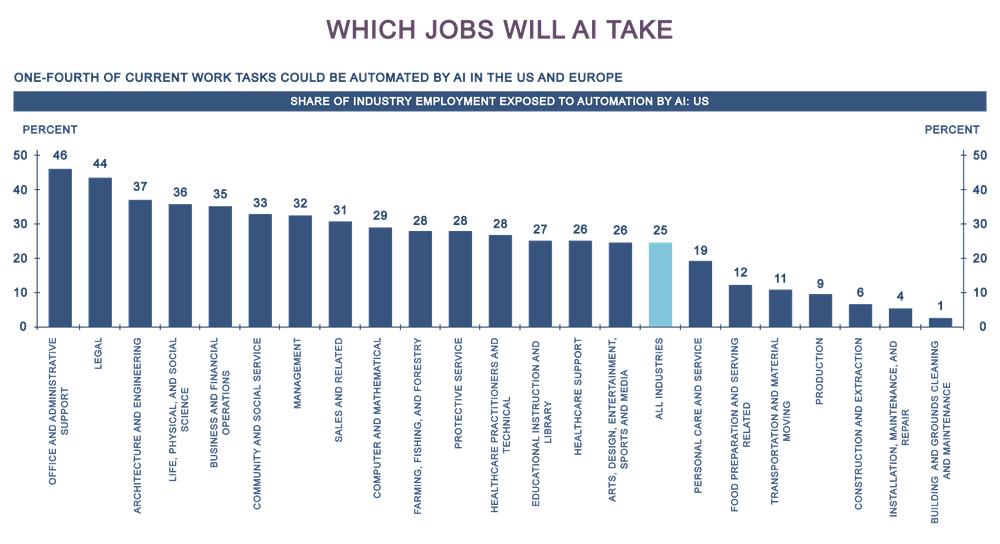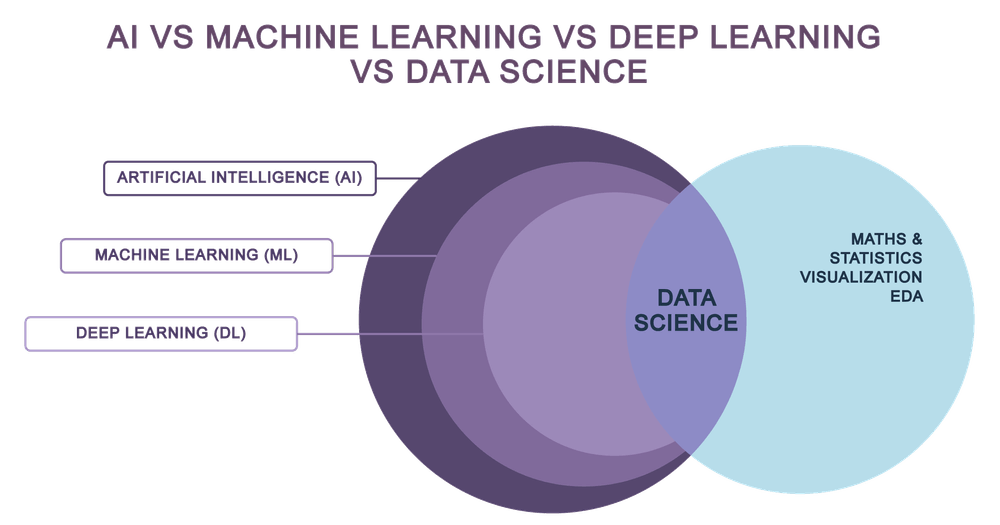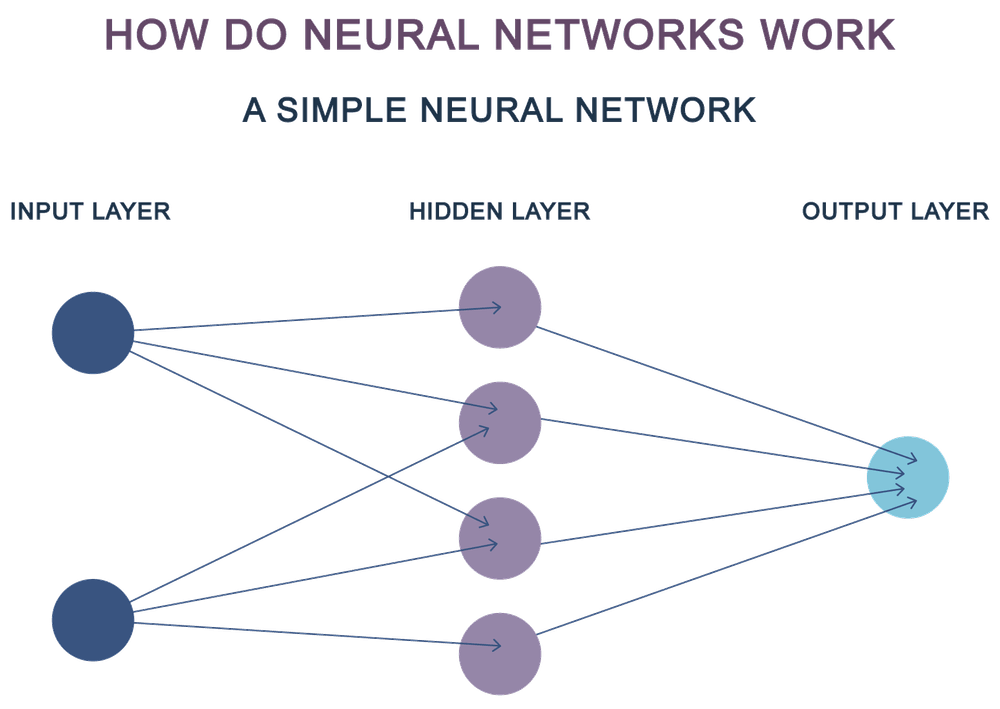After reading this article, you’ll understand AI, machine learning, and deep learning. You’ll know how to talk to your colleagues about it; what types of machine learning models exist; and how can AI benefit EdTech. Let’s get started.
Part 1: what can AI do in elearning?
AI will not replace educators. Not yet.

Many people are worried that AI will take their jobs. The fears are valid. According to Goldman Sachs, AI can automate 300 million jobs. In the education sector, 27% of workers are exposed. But AI will not replace teachers – they only have a 9% risk of automation.
What can educators do to pull through? There are two approaches: try to ban AI or embrace it. Historically, technology bans are shortsighted. Just look at how it’s worked for the Luddites.
The good news is that technology will not only automate old jobs but create new occupations as well. So far, technology has always created more professions than it took away. Today, 60% of workers have jobs that didn’t exist before 1940.
Transform education with AI solutions
Leverage our AI-powered solutions to enhance learning experiences, personalize education, and improve outcomes.
In any case, drastic changes are unlikely anytime soon. As the ChatGPT hype is settling down, people realize the limitations of generated content.
You can’t trust AI content. Language models like ChatGPT generate text that looks right, but it doesn’t mean that it’s correct. They simply choose appropriate words one by one, using statistics. They don’t understand the meaning behind the words.
It’s still banned in many schools. Many school districts prohibit AI for students and teachers. While some places like NY have already lifted the ban, AI presence in education is still debatable. Some look forward to the future with AI, others steer clear of it.
It’s not as smart as you’d think. Developing general intelligence is risky. For one, it could destroy us all.
But there are many other concerns:
- Reducing maintenance costs;
- Keeping it unbiased;
- User privacy protection;
- AI’s decision making control.
This could be why both GPT 3.5 and 4 are getting dumber. Until we know more about AI, models like ChatGPT may not be used at full capacity.
AI tools for education
Personalize courses with analytics
Most curriculum publishers don’t have a full picture of student engagement. Without AI, publishers rely on very basic tools: they can check grades or ask students if they’ve enjoyed the course.
AI takes this to the next level. With good analytics, EdTech companies understand exactly which parts of the course to improve. For example, they’ll see when the students pause or skip videos.
It can personalize courses, too. AI can provide additional challenges for top students, or explain topics in more detail to the low performers.
Optimize administrative tasks
Computers handle statistics much better than humans.
Neural networks can spot patterns that escape our eyes. Imagine two mischievous couples in class: Alex and John + Mia and Sophia. If they’re apart, all is well. When the four unite, chaos begins and they start bothering other classmates.
In any complex system, there are hidden patterns. AI can untangle the patterns to simplify operational tasks:
- Scheduling;
- Classroom and locker layouts;
- Staff allocation;
- Enrollment;
- Transportation planning;
- Event scheduling.
Simplify assessments
AI makes grading faster. It can zip through complex exams while understanding student intent. This will free up educators to focus on more engaging tasks. In some cases, teachers need to step in, and AI can help find such situations.
Also, with ChatGPT students got a new way to cheat. How can we ensure that learners do their own homework? It’s simple, just use another AI to identify plagiarism.
Get an AI teaching assistant
AI bots can answer any question in an instant (granted, they’re not always correct yet). They save time but also make students feel supported. Some students use ChatGPT in English classes to translate Shakespeare’s tragedies into modern English.
An AI teacher assistant can make classes more fun. One student generated a Kanye West-style rap about trigonometry.
For EdTech businesses, AI can become a true game-changer
Custom solutions are not limited to the AI tools listed above. Aristek’s experts specialize in fine-tuning solutions to meet your specific challenges. Don’t hesitate to ask questions if you have any!
Part 2: how does AI work? In simple terms
Main AI concepts: AI, machine learning, and deep learning
These words are often used as synonyms. The terms are close, but they mean different things.
Think of an onion, with several layers inside each other. The AI concepts are like that. All machine learning is AI, but not all AI is machine learning. Let’s start peeling the onion from the top.

Artificial intelligence (AI) is a technology that helps machines mimic human intelligence. AI systems can see, learn, solve problems, make decisions, and so on.
That said, don’t confuse artificial intelligence with general artificial intelligence. Today’s narrow AI is good at specific tasks, but it lacks broad cognition and consciousness of general AI. It can play chess, generate text, or forecast weather. But it can’t deal with the full range of human tasks.
Machine Learning (ML) is a subset of AI that relies on adaptive learning. Machine learning behavior is not explicitly programmed, the algorithms learn autonomously. That’s why such models can get better over time and not stay rigid.
By contrast, non-ML AI models are rigid and rule based. When a computer can’t execute a line of code, it freezes not knowing what to do. If operating systems could handle unconventional situations with ML, we wouldn’t have “blue screens of death”.
Most modern AI systems apply at least some elements of machine learning. That’s why the terms are often used interchangeably. But you can still find non ML AI models in fields like robotics, speech, or image recognition.
Deep learning (DL) is a subset of ML that uses neural networks. A neural network is a set of different formulas that mimic how our brains work.
To train the model, developers upload real-world input and output data. The AI will try to find connections between input and output. They are called the hidden layers. At first, the hidden layers are random and can be incorrect. But after each step of training, the connections become more accurate.
Let’s say, you want to create a neural network that predicts exam grades. First, you need a random hypothesis. Does perfect attendance equal perfect test scores? The model tests it and compares the results to real world data. If the results were not correct, the neural network will work the math magic to come up with better predictors of test scores. This process will take many iterations, until the developers are satisfied with the accuracy.
The more diverse your input data, the more accurate the results. To estimate exam scores, you may need to collect more than just attendance. It could be student grade history or time spent on finishing homework.

What Types of Machine Learning Models Exist
There are plenty of different models, but we’ll focus on the high level types.

Supervised learning models learn by example. To train the model, developers feed it with extensive input and output data. As the AI identifies patterns, it can predict outcomes of new data.
There are two main types of supervised models:
- Regression models find connections between variables. You can visualize such connections in a chart with X and Y axes, as in the picture above. If 1 cup of coffee costs 5 dollars, you can predict the price of 10 cups. That’s called linear regression.
- Classification models sort items into categories. Imagine a full fruit bowl. If I ask you to pick all the bananas out, you’ll instinctively look at the shape, color, and so on.To people, classification is simple and automatic. We don’t need to have seen a billion bananas to tell them apart. Computers do, and that’s why we still have captchas (although bots have become better at it).
Supervised models are great when you have lots of labeled data. They are perfect for content recommendation systems, automated grading, and language learning tools.
Unsupervised learning doesn’t have human guidance. Developers feed AI with large datasets and let it find patterns on its own.
Clustering is a popular type of unsupervised learning. It’s similar to classification, except the data is unlabeled. Instead of looking for bananas in the fruit bowl, you’d separate exotic fruits – even if you don’t know what they are.
Use such models when you need to identify trends, organize content, or cluster students.
Reinforcement learning models are trained with feedback. The algorithm interacts with the environment, and receives feedback – either rewards or penalties. The AI learns to maximize actions for long-term rewards.
Back to the fruit bowl example. Imagine that you need to pick a papaya out of the bowl, but you don’t know what it looks like. If you pick the right fruit, you can eat it. If you pick something else, you’ll get hit with a stick. That’s reinforcement learning.
Use reinforcement learning models when you have a dynamic environment. With such models, you can simulate physics experiments, create adaptive learning paths, or power your interactive learning games.
How to collect learner data for AI
To train an AI algorithm, you need to first feed it with data. The better your data, the more accurate the algorithm. That is true, regardless of the machine learning model.
But how to collect all that data?
xAPI (Tin Can) is a protocol for tracking learning experiences. If you want to analyze learner actions, you’ll need xAPI.
With it, you can track any user actions. It’s the first multi platform protocol supporting mobile, desktop, web, and even wearable devices.
There’s plenty of trackable information about users. Here’s some example of what you can learn:
- Which parts of a lecture do learners skip?
- What grades do they get?
- Which quiz questions are the hardest?
- What actions and decisions do learners make in games?
If you don’t want to track student experience, you can get along without other protocols. For example, with OneRoster you can collect student data from the SIS. You’ll collect rosters like grades, classroom attendance, or locker location. With that, you can still locate at-risk students.
Do I need AI in elearning
AI is the most efficient way to analyze data and build predictions. Today, all robust analytics is based on AI.
But there’s no need to invest billions of dollars into the most advanced neural networks. Simple solutions often work best. Banks still estimate credit scores with regression models like decision trees.
If you want to introduce powerful AI without spending too much – get in touch. We’ll give you a free consultation, with no strings attached.
Why do we spend our time helping anyone for free? Some of you will become our clients, some will become partners. The rest will simply become a bit more tech educated.




